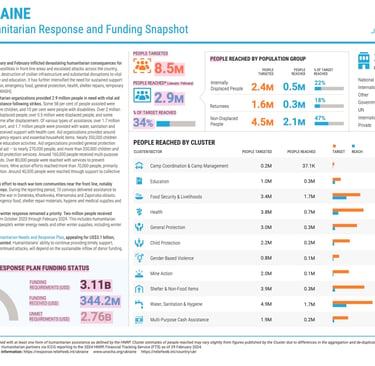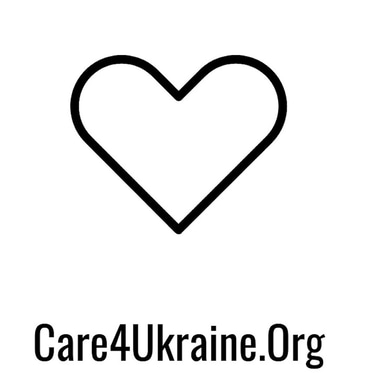Providing Humanitarian Aid in Ukraine
Learn about our work in Ukraine since 2015, where we provide medical, educational, and community support to IDPs and children.
5/11/20243 min read
24.05.05
Kyiv, Ukraine
National NGOs………. 274
International NGOs... 93
Other……………………… 11
Government…………… 10
UN…………………………. 8
International Org. ….. 1
Private ……………………. 1
The above chart is a synopsis of the number of aid groups working in Ukraine. It is provided by the United Nations Office for the Coordination of Humanitarian Affairs (OCHA). It is a United Nations (UN) body established in December 1991 by the General Assembly to strengthen the international response to complex emergencies and natural disasters.
If you look at the overview prepared by OCHA (in the Photo Section of this update) in February of 2024 you can see that of the 8.5 million people in Ukraine that needed humanitarian aid assistance less than 3 million people were reached.
Being on the ground in Ukraine trying to help the women, children and elderly displaced by the war we are proud to be included in this effort. We are also hugely grateful for all your generous donations. Without your gifts we couldn't do our work.
Again, thank you for all your support.
Text of the OCHA Update (29 February 2024)……..
SITUATION UPDATE
The relentless waves of attacks in January and February inflicted devastating humanitarian consequences for millions of people in Ukraine. Ongoing hostilities in front-line areas and escalated attacks across the country, resulted in significant civilian casualties, destruction of civilian infrastructure and substantial disruptions to vital services, including access to health care and education. It has further intensified the need for sustained support for child protection, counseling, education, emergency food, general protection, health, shelter repairs, temporary housing, water, hygiene and sanitation (WASH).
In the first two months of 2024, humanitarian organizations provided 2.9 million people in need with vital aid and services, including emergency assistance following strikes. Some 58 per cent of people assisted were women and girls, almost 20 per cent were children, and 10 per cent were people with disabilities. Over 2 million people reached were war-affected non-displaced people; over 0.5 million were displaced people, and some 0.3 million were people who returned home after displacement. Of various types of assistance, over 1.7 million people received food and livelihood support, and 1.7 million people were provided with water, sanitation and hygiene services. Over 650,000 people received support with health care. Aid organizations provided around 320,000 people with materials for emergency repairs and essential household items. Nearly 350,000 children and teachers were supported to continue education activities. Aid organizations provided general protection support - including counselling and legal aid - to nearly 270,000 people, and more than 200,000 children and caregivers were reached with critical child protection services. Around 160,000 people received multi-purpose cash assistance to cover their basic needs. Over 80,000 people were reached with services to prevent gender-based violence and support survivors. Mine action efforts reached more than 70,000 people, primarily through mine-risk awareness and education. Around 40,000 people were reached through support to collective centres for displaced people.
Humanitarians continued to make every effort to reach war-torn communities near the front line, notably through inter-agency humanitarian convoys. During the reporting period, 10 convoys delivered assistance to nearly 17,000 people most impacted by the war in Donetska, Kharkivska, Khersonska and Zaporizka oblasts.
They brought essential aid, such as emergency food, shelter repair materials, hygiene and medical supplies and other vital items for winter.
During the first two months of the year, winter response remained a priority. Two million people received critical winter supplies and services from October 2023 through February 2024. This includes humanitarian support for district heating, aid to meet people's winter energy needs and other winter supplies, including winter clothes, fuel and heaters.
In the first two months of 2024, the Humanitarian Needs and Response Plan, appealing for US$3.1 billion, received 11 per cent of the funding requested. Humanitarians' ability to continue providing timely support, including in response to the impact of continued attacks, will depend on the sustainable inflow of donor funding.”


